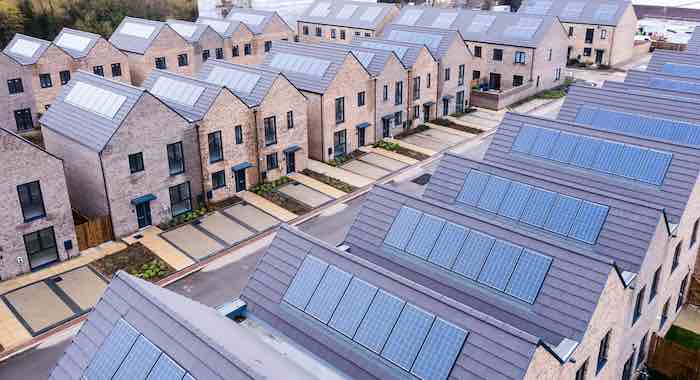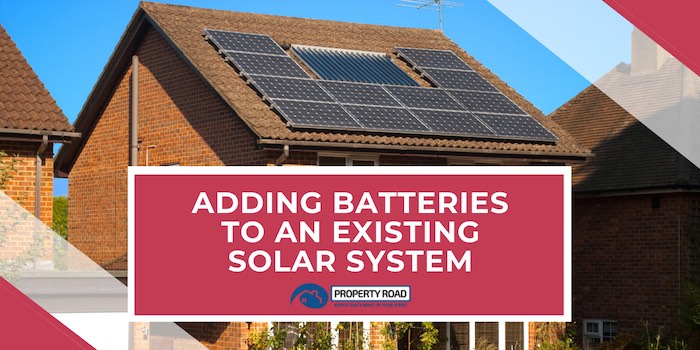You may have new or well-established solar panels on your home’s roof and may now be wondering about adding batteries to an existing solar system.
The answer for many homes with a solar array system in the UK is that you can add them, but the solar panels may need some rewiring, and if you have an unsuitable inverter system, you’ll need to buy a new one.
In most cases, adding a battery is possible, but a lot depends on whether your system has been designed with batteries in mind. That might not be the case for older systems.
There are several reasons why adding batteries to an existing solar panel system makes sense, including:
- Storing excess solar energy that you generate during the day;
- Using that stored energy later, particularly at night – reduces your electricity bill;
- Coming off the grid;
- Delivering energy security for your home and family.
The bottom line is that by adding solar batteries, you’ll be storing energy that is generated in the day and using it for non-production hours, particularly at night or cloudy days, so your home will then be using 100% renewable solar energy, 24 hours a day – or for as long as the battery can provide a supply.
The technology is constantly improving – particularly the lifespan of the batteries and their costs which is making them a realistic prospect for cutting bills in those homes that have solar panels installed.
However, as the Property Road team explains, you’ll need to understand several issues before proceeding.
Understanding your system’s power output
The first step is to appreciate that solar panels do vary, and they have, depending on the installation, varying output voltages.
Most domestic solar panels fitted to UK homes tend to have a voltage output of between 30V – 50V.
These panels can be wired in parallel or in a series so that the correct voltage is supplied for the system’s inverter.
And if you don’t know what the inverter is, this is the tool that converts the DC voltage from your solar panels into AC voltage for use as your main electric supply.
Essentially, you need to understand:
- When solar panels are wired in a series, the voltages will mount up, but the current output – or amps – remains the same;
- When your solar panels are wired in parallel, the voltage for output remains the same, but the current will increase.
How much do solar batteries cost?
While the price of batteries for solar panels has fallen in recent years, as has the installation cost, this is still an expensive undertaking.
You might be interested in fitting batteries to be environmentally friendly or to enjoy lower bills, so you’ll need to weigh up the pros and cons.
Depending on the battery type and manufacturer, you could be spending between £1,250 and up to £6,000 for a lithium-ion battery that has a capacity of between 9kWh and 13.5kWh. The battery’s life cycle and capacity will also be important.
With growing numbers of homeowners fitting batteries to their solar arrays, these prices will continue falling, so it’s important to shop around.
Are grants available for fitting solar batteries?
It is certainly worth checking online or with an experienced installer as to whether there are grants available for fitting batteries. The rules change regularly, but there have been Government schemes to encourage the take up of solar panel battery installations.
One example is the Smart Expert Guarantee (SEG) scheme which means you can be paid for exporting stored electricity to the grid. These tariffs vary between energy providers, but the rates are around 4-6p/kWh.
What is a charge controller?
You will need a charge controller when charging the batteries, and that will convert the system’s generated DC output – not the inverter.
The charge controller will convert the supply to the appropriate voltage for charging the batteries. These charge controllers are available in 12V, 24V, or 48V.
If your home has a high-power solar array installed, then you will need the 48V charge controller and possibly more than one battery.
For mobile and smaller arrays, the 12V and 24V charge controllers will be used.
Top tip: A solar battery installation expert will highlight that if the voltage output of your home’s solar panel system is not in the charge controller’s correct range, then the panel will need rewiring.
However, it’s worth noting that your existing system’s inverter may be suitable when you fit batteries.
That means that a charge controller for a 48V battery set-up will need an inverter that can accept a DC input of 48V.
While this may sound technical, you may find the documentation for your current inverter explains whether it will be suitable for use. If the inverter is unable to accept a 48V input, then it will need replacing.
Buy an all-in-one unit
It’s also possible to buy an all-in-one unit that includes the inverter and the charge controller in one box. These are simpler to instal and will require less wiring.
Though, if your current inverter does not need to be replaced, it will be cheaper to install a charge controller and retain the existing inverter.
Choosing the size of the solar power system’s battery bank
When it comes to choosing your solar power system’s battery bank, you will have to appreciate how much electricity you are using.
For typical domestic use every day, you’ll find that battery banks of between 3kWh and 15kWh will be appropriate.
It helps that an experienced installer will offer an assessment and explain what you need to enjoy battery power.
Types of batteries used for storing electricity
You also need to appreciate that there are two types of batteries used for storing electricity generated from solar panels. They are:
Lithium-ion
These batteries will, when used regularly, have a lifespan of up to 15 years – most manufacturers will offer a warranty of 10 years. These batteries also tend to be more efficient and lighter than lead acid and are safe to install in a loft. They also require less maintenance than lead acid.
Lead acid
A battery bank of lead acid will have a life of up to 7.5 years – though this can vary depending on how regularly they are charged and then discharged. The issue with lead acid batteries is for them to operate at their best, they require regular maintenance.
Other battery questions you may be asking

The question of adding batteries to solar panels can appear to be daunting, so here are some answers to commonly asked questions.
Can I mix solar batteries?
It is not a good idea to ‘mix and match’ solar system batteries. The better results will come from using batteries from the same manufacturer – and be safer.
Do I need an inverter for solar batteries?
There’s no need to have an individual inverter for every battery, and you can add several batteries to the system.
Which is the best battery storage system?
It is generally regarded that lithium-ion batteries are the best since they last longer and are more efficient.
How many solar batteries should I install?
A lot depends on how much electricity you use at night. For a busy household, you might require two or more batteries to power several appliances at the same time.
Can I charge batteries directly from solar panels?
It isn’t possible to charge batteries from the solar array. You will need a charge controller to help protect your battery when it is being charged. You will also need an inverter for changing the panel’s DC current into useable AC current.
How solar power batteries affect your feed-in tariff (FiT)
Lots of people who install solar panels do so to reduce their electricity bill and enjoy an income from the Feed-in Tariff (FiT). This was a scheme that saw the government pay you for generating electricity that is sent to the grid. It closed in 2019.
However, when you use battery storage for a solar array system, you will be exporting less solar generated electricity to the National Grid.
That’s because the energy you will be generating will be used in your home, or for charging your batteries. Only after the batteries are charged will you be exporting electricity again.
As a result, your feed-in tariff payments will probably fall as a result.
However, it’s also worth checking whether there is an electricity company willing to take the energy stored in your batteries for their own supply.
Adding batteries to an existing solar system in the UK
Essentially, adding batteries to an existing solar system in the UK is a straightforward exercise, but you should understand:
- The costs involved
- Whether your solar panel system can be utilised
- The batteries will be warrantied for 10 years – so they may need replacing before your solar array reaches the end of its life
- You will need to place the batteries in a secure location – probably your loft
- They will need to be maintained
- Understand that your FiT payments (if you get them) may fall as a result
- You can sell your battery’s stored energy, but not all energy firms will accept the export
The upside is that installing storage batteries means reducing your electricity bill – and it is these savings that could really add up.
The big downside is the cost of installation, and you will need to calculate whether the upfront expense will be worth it when comparing how much you will save on your electricity bill.
You won’t need to use your electricity supply while the batteries are being discharged – and the batteries have effectively been charged up for free!




